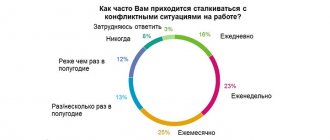Concept of social conflict
The concept of social conflict is much broader than it might seem at first glance. Let's figure it out together!
In Latin, conflict is translated as “clash.” In sociology, conflict is the highest stage of contradictions that arise between people or social groups. The reason may be opposing goals or interests. There is even a separate science that studies this issue - conflictology.
Within the subject of social science, social conflict is a form of social interaction between people and groups.
Functions of social conflicts:
- positive:
- informing about social tensions;
- relieving social tension;
stimulation of problem solving, social change;
- creating stressful situations;
disorganization of social life;
Possible stages of conflict:
- Pre-conflict situation - the parties feel emotional tension, strive to overcome it, understand the reasons, evaluate their capabilities, choose a strategy of behavior and methods of influencing the opposite side.
- Conflict is a situation where it is impossible for the parties to agree, open and hidden actions of the parties to the conflict.
- Conflict resolution - finding out the causes of the conflict and eliminating them.
Let's continue to learn what social conflict is and move on to the topic of causes and structure.
Basic Completion Methods
One way or another, the conflict is coming to a logical end. The way out of the conflict occurs in different ways. Sometimes the end of a conflict does not end with its resolution. In this case, it only subsides for a while, goes into a permanent state and over time can arise again. Much depends on how much each side understands the cause of the conflict.
There are six main ways to end a conflict:
- compromise, consensus - achieving agreement, agreements, a mood for concessions;
- negotiations – dialogue, discussion of problems by the parties;
- mediation – involving a third party in resolving disputes and contradictions;
- arbitration – refers to conflicts between legal entities, their appeal to the courts and authorities;
- use of force – squeezing out a competitor using force;
- avoidance is avoidance of resolving a conflict situation.
Typology of conflicts
The structure of any conflict:
- Subjects of conflict: intrapersonal, group, interpersonal, intergroup.
- Object of conflict: values and interests.
- Foundation: ethnic, economic, political.
- Conflict type: rivalry, competition, confrontation.
- Consequences: constructive and destructive.
Subjects of the conflict situation:
- witnesses - people who observe the development of the conflict from the side;
- instigators - people who push others into conflict;
- accomplices - people who help (consciously or not) the development of the conflict in different ways (advice, technical or organizational assistance, etc.);
- Mediators are people who try to prevent, stop or resolve conflict.
The subject of the conflict is the possession of one or another resource
The cause of the conflict is the circumstances that led to the clash between the two sides. The reason is expressed in the need to use resources.
The reason for the conflict is an event after which a contradiction appears. Reasons can be spontaneous or deliberate.
Contradiction is a disagreement between the points of view of the conflicting parties on economic, cultural, and political issues.
Let's talk in more detail about the reasons, and then consider the types of social conflicts.
Prepare for the Unified State Exam in Social Studies with courses from Skysmart - fun and effective!
SOWY.RU
Conflict is a clash of different interests; a natural process that should not be feared. With the right attitude, conflicts can teach us how to interact optimally with the world, get to know ourselves and people better, and reveal a diversity of points of view. Resolving interpersonal conflict brings relationships to a higher quality level, expands the capabilities of the group as a whole, and unites it. A conflict situation is an accumulation of disagreements that contain a significant cause of conflict.
An incident is a set of circumstances that serve as the basis for a conflict.
Conflict is open confrontation as a consequence of mutually exclusive interests and positions.
Conflict resolution is its final stage.
Ways to resolve social conflicts
Existing methods (models) for resolving social conflicts
Resolving a social conflict is overcoming the main contradiction in the interests of the parties, eliminating it at the level of the causes of the conflict. The resolution of the conflict can be achieved by the conflicting parties themselves without the help of any outsiders, or by involving a third party (mediator) in the solution. Thus, a conflict resolution model is a set of certain methods for overcoming it. This is not a randomly chosen method, but directly depends on the indications of the diagnosis of a specific conflict.
Models used in conflict resolution are formed on the basis of cultural and legal attitudes towards conflict existing in society, encouraging or prohibiting one or another method of conflict resolution. The model for resolving any conflict is based on the use of various methods - violent (repression, demonstration of force, various forms of coercion) or peaceful (negotiations, agreement, compromises).
There are four fundamental ways (models) by which conflicting parties can resolve their differences and exit the state of conflict:
1. force (unilateral dominance), 2. compromise, 3. integral model, 4. separation of the parties. A certain combination of these four methods is also possible (symbiotic model).
Unilateral dominance (power model) is a method that involves satisfying the interests of one of the conflicting parties at the expense of the interests of the other. Forceful methods of resolving a conflict, in fact, lead to the destruction or complete suppression of the interests of one of the parties to the conflict. In this case, a variety of means of coercion are used, from psychological to physical. Often this is a way of transferring blame and responsibility to the weaker party. Thus, the real cause of the conflict is replaced and the dominant will of a stronger subject is unilaterally imposed.
The forceful method is used when one of the subjects is very active and intends to continue in the conflict to a victorious end. The desire to resolve a conflict from a “position of strength” is usually expressed in ultimatums, threats, and violent actions in order to achieve submission from the enemy and force him to do what is required of him. The weaker party is forced by force to submit and comply with the demands of the stronger party. This model is more often used by people who overestimate their strength. It is called forceful because the victory of one side is always the result of the use of some kind of force. Domination of one side over the other is carried out using various means, depending on the nature of the conflict: the use of power, economic resources, influence, authority, moral influence, etc. Official position is a solid advantage in a conflict with a subordinate. Inexperienced managers, to resolve the conflict in their favor, use such methods of forceful influence on the opponent as increasing his workload, creating inconveniences and difficulties for him, applying disciplinary sanctions, etc. Such actions irritate the subordinate, make him uncompromising, and make it difficult to resolve the conflict. The conflict can be resolved in this way with the help of fights, fist fights, and everyday activities. Such dominance usually gives rise to opposite actions in the form of mass disagreement, protest forms of behavior (strikes, demonstrations, passive resistance, etc.). The power model resolves conflict according to the principle: “strong is always right.” This means, as has been repeatedly noted, not only the use of physical force: violence can take the form of administrative, official, etc. influence. “The boss is always right” is one of the particular formulations of the same principle.
The history of mankind is filled with many examples of resorting to force to resolve conflicts at various levels - from assault in personal relationships to draconian measures of power against its people and world wars. Violence has been a constant source of tragedy and loss of life, but it will continue to exist for a long time. The principle “might is always right” marks, first of all, the triumph of stupidity. The ability to quickly end the struggle, “in one fell swoop,” is perhaps the only advantage of the forceful method of resolving social conflict. However, strategically, forceful resolution of conflict is always ineffective. The side suppressed by force remains dissatisfied with such a solution to the conflict. This pushes her to hidden resistance, and sometimes to open opposition to the victorious opponent, to revenge, to suppress which violence will be required again and again. It is generally accepted that when resolving a conflict from a position of strength, only the losing side suffers. But in fact, the conflicting side that wins by force, in order to maintain its superiority, must constantly make efforts to maintain its victory. This means that the winner constantly needs to spend his resources (military, material, intellectual, psychological). The inevitability of retribution for violence increases immeasurably. People oppressed by force, as a rule, do not accept the fate of the vanquished. A conflict that has been extinguished for a while grows again as soon as the force that restrained it weakens. The conflict in this way can be finally resolved only with the complete destruction of the losing side. While she is alive, her dissatisfaction remains to live - a constant source of problems and tension for the winner. And even if the other side is completely destroyed, the winners still often receive moral condemnation in society. Thus, Dantes and Martynov, who won conflicts in duels A.S. Pushkin and Yu. Lermontov, all their lives were forced to justify themselves and pay for these victories - even their descendants could not forgive them for the shed blood of the great poets. Thus, resolving a social conflict from a position of strength often turns out to be very expensive for the winner and, moreover, a very dubious success. Unfortunately, it must be said that this model is quite common in Russia.
The power model can be used only in rare cases - if, when diagnosing a conflict, a set of the following indicators simultaneously exists:
• the conflict was provoked by the opponent, • support for the conflict from public opinion and authoritative mediators, • a large number of innocent victims in the conflict, • antagonism of the interests and goals of the conflicters, • growth of the area of disagreement, • the conflict is in a vicious circle, • the current sign of the conflict is “plus” -minus" and "plus" for the social system.
On the side of the conflict (there must be complete confidence that this side of the conflict really represents a “plus”, and the other “minus”:
• both conflicters are focused only on victory, • the balance of power is in favor of the conflicter who intends to apply this model. • significant duration of the conflict, • high cost of maintaining the conflict; the cost of a forceful exit from the conflict is less than the cost of maintaining the conflict, • the subject of the conflict is socially significant.
These limitations to the use of the power model are not known to everyone. Unfortunately, this method is used in our society much more often than it should.
Separation of the parties to the conflict. In this case, the conflict is resolved by stopping interaction, severing relations between the conflicting parties, isolating them from each other (for example, divorce of spouses, separation of neighbors, transfer of workers to different areas of production). The separation of the conflicting parties can be accomplished by their retreat, when they both leave the “battlefield”. This is how, for example, a squabble between bus passengers ends when one of them gets off at his stop, or a quarrel between neighbors in a communal apartment, which stops after they move.
The model provides effective and radical overcoming of the conflict, but threatens the destruction of the social system, the elements of which were the conflicters. As a result of a breakdown in contacts between the parties, their common cause collapses, the organization whose activities ensured their existence occurs.
Therefore, it is applicable only if strictly certain conditions are met:
• the presence of “conflict parties” and the absence of a “conflict swamp”, • the intervention of authoritative and independent mediators, • an increase in the number of innocent victims in the conflict, • antagonism of the interests and goals of the conflicters, • an increase in the area of disagreement and the boundaries of the conflict, • the stage of development of the conflict – “vicious” circle”, • current sign of the conflict – “minus-minus”, • approximately equal balance of forces of the parties, • longer duration of the conflict, • increased psychological background of the conflict, • the cost of maintaining the conflict is greater than the cost of leaving it.
Separation of conflictors does not always completely resolve social conflict. And it is not always possible. Spouses are connected by children, and in our living conditions, divorced people are not always able to separate; warring national communities cannot and do not want to leave the territory where they live mixed with each other, side by side. The separated parties, having gotten rid of conflicting relationships with each other, are forced to look for replacing destroyed social contacts with new ones, and it is unknown whether the latter will become less conflicting (as often happens when divorced spouses enter into new unsuccessful marriages). Therefore, it is not surprising that separated conflicters sometimes resume contacts after some time, or even get back together. The forceful model of conflict resolution and the disjunctive model of conflict resolution are the most primitive, but, unfortunately, in Russia they are used most often.
The compromise model is a way of reconciling conflicting interests, which consists of mutual concessions in the positions of the conflicting parties. It is important to know that the compromise model of conflict resolution is based on concessions to conflicts precisely in their interests. Thus, the concept of compromise is used in different senses: in the ordinary understanding, it is various concessions to each other, and in a conflict, it is the mutual refusal of the parties to the conflict from any part of their claims, mutual sacrifice of interests, in order to achieve agreement.
The main advantage of peaceful resolution of a conflict through compromise is introducing the conflict into a constructive framework and establishing the process of communication between the parties, finding certain points of agreement (compromise). Nevertheless, a compromise, according to the famous Western conflict expert K. Lazuela, “is a patchwork quilt that the conflicters pull over themselves.” Compromise, as a model for resolving a conflict, is certainly preferable and more civilized than force or separation, but it is not universal and has its limits of applicability. One should not think that any conflict can be easily resolved on its basis.
It works best if the conflict is characterized by:
• the motivations of the conflicters coincide in the main, • the parties have more common interests than the opposite ones, • the goals of the conflicters correspond to their interests, • the area of disagreement between the parties is not noticeably expanding, • the conflict in its development has not reached the stage of ideological confrontation of the parties, • an actual sign of the conflict – “plus-minus” or “plus-plus”, • the predominance of “pluses” over “minuses” in the previous phases of the development of the conflict, • there is an intention of the parties to make concessions. • approximately equal balance of power between the parties, • the conflict is not acute. The psychophone of the conflict is normal; • the cost of maintaining the conflict is greater than the cost of leaving it.
Integral model (integral strategy) - provides for the possibility of satisfying the interests of all conflicters, subject to their revision (revision) of their previously formed positions, the goals that they intended to achieve in the conflict. It is called integral not because it combines the qualities and advantages of previous models, but because it is capable of integrating the interests of conflicting parties. When using it, no one sacrifices their interests. Each conflicter seeks to satisfy his interests, and therefore feels like a winner. To achieve such a desirable outcome, the conflictors must abandon their position and reconsider the goals they set in this conflict.
Let us give an example demonstrating the differences in conflict resolution models. Let's assume that you and a group of students are in a university classroom during classes, which is quite hot and stuffy. You suggested opening the only window. The listeners sitting next to you supported you. But colleagues who arrived in the classroom before you and took seats under the window opposed your proposal. They said that they were already well, that they were afraid of drafts and colds and did not intend to risk their health for the sake of the whims of other people. How to resolve the conflict that has arisen?
Let's consider possible solutions:
1. (force) will take place if you and your supporters create a scandal, try to prove your truth by force of argumentation and vocal cords, try to open the window yourself, overcoming the physical resistance of your opponents. Instead of ending the conflict, it will escalate and the conflict situation will develop into an incident. Even if you manage to open the window and keep it open and become a winner, then in fact you will lose, because... do not satisfy the interest for which you came to the classroom - to listen to the lecture. 2. (the tricky method) will be that you will leave the classroom, thus missing an important lesson for you. 3. (compromise) method will work if you (and your supporters) agree with your opponents to partially open the window (a little) or part of it - a window or transom. But at the same time, neither you nor your opponents will be fully satisfied with such a decision, because almost no fresh air reaches you, and those who are afraid of drafts still risk catching a cold. And all this prevents you, your supporters, and your opponents from working normally in class. 4. (integral) model. You can refresh the audience not only in the way you insisted on, but also by: a) opening the door leading to the corridor; b) turning on the air conditioner or fan; c) organizing a short ventilation of the room during a break, during which everyone will leave the audience; d) finally, those who are afraid of a cold can move to seats away from the window - to where it is not blowing.
As we see, if you don’t get hung up on achieving your goal - to have an open or closed window, then you can find solutions to the problem that will not infringe on anyone’s interests, and, consequently, further escalate the conflict. The integral model is more perfect than both power, adjustment and compromise. This strategy is recognized by conflictology as universal and suitable for any type of social conflict, the most effective and socially useful. Only on its basis can “minus-minus” conflicts be resolved. The integral model is quite applicable to conflicts with all other signs and formulas, as well as different relationships between constructive and destructive functions. The development of this strategy and specific technologies for its implementation is considered the most important merit of conflictology. The integral model in the literature is designated differently: in American conflictology it is called the “third way of behavior of conflicters” or “a model not for fools”, in the European scientific tradition - “revision of goals”, in Russia - “integral method” or “integrative strategy " As a rule, the integral model is achieved as a result of negotiations between conflicting parties, ending with the adoption of an agreed decision. In order for the conflict to be truly resolved, it is important that the conflicting parties agree among themselves, so that they themselves find the most suitable way out of the conflict situation. In practice, conflicting parties usually enter into some kind of negotiation before resorting to violence and or disunity. The integral model of conflict resolution is an important discovery of the twentieth century in the field of public institutions. One of the many paradoxes of modern Russian society is that the most effective and rational way to resolve conflicts is used much less often than it should be. In Russia, the majority of our fellow citizens do not know that a similar model for resolving conflicts exists, and if they do know, they do not like to use it. This is explained by a complex of reasons, among which we note the peculiarities of the mentality of Russians, expressed in an increased commitment to forceful decisions, with the peculiarities of upbringing - we are always taught that the goal is above all and the Russians’ misconception about integrity. Many people equate adherence to principles with stubbornness in one’s own way, with refusal to reconsider one’s position in a conflict, regardless of what caused this position. At the same time, it is overlooked that the interests of people and their groups are always more important than the goals that they set for themselves in order to achieve these interests. You must be flexible in setting and changing your short-term goals, while constantly taking care of your long-term vital interests. Unfortunately, many do the opposite. Refusing to reconsider their positions, without taking into account the new conditions that made them unreasonable, they continue to defend them, which complicates the achievement of fundamental interests.
There are also symbiotic methods of conflict resolution - models that combine in a certain sequence - force, compromise, separation and integral models of conflict resolution.
Source - https://info.yarnet.ru/rieltor/index.php?id=90
Causes of social conflicts
The most common causes of conflicts:
- Beliefs and personal interests. A clash of views, including religious principles, differences in cultural, political or economic worldview.
- Ways to satisfy needs. The process of eating and methods of organizing safety may infringe on the interests of others or cause public censure.
- Social disorganization. The problem of social inequality causes conflict between social groups from year to year.
What is conflict management and resolution?
The settlement and resolution of conflicts is usually understood as a system of measures aimed at preventing conflicts and finding optimal ways out of them. For many years, this problem has not received due attention either in the theory of social psychology or in its practice.
Only in recent years have communities of conflictologists and various organizations involved in applied conflictology begun to form, and thematic literature has also begun to be published. However, even now it is impossible to talk about the fact that there is any effective system in the field of conflict resolution.
We can even speak with confidence about the opposite state of affairs, because when resolving conflicts, a number of mistakes are often made.
Types of social conflicts
Let us list the main types of social conflicts.
By the number of participants in the conflict:
- intrapersonal (interesting to psychologists and psychoanalysts);
- interpersonal (for example, between friends);
- intergroup (for example, competition between firms).
According to the direction of the conflict:
- horizontal (between people of the same level, for example, manager versus manager);
- vertical (employee versus management);
- mixed (both).
According to the function of social conflict:
- destructive (a fight on the street, a fierce argument);
- constructive (a duel in the ring according to the rules, an intelligent discussion).
By duration:
- short-term;
- protracted.
By means of resolution:
- peaceful or non-violent;
- armed or violent.
According to the content of the problem:
- economic;
- political;
- production;
- household;
- spiritual and moral, etc.
By the nature of development:
- spontaneous (unintentional);
- deliberate (pre-planned).
By volume:
- global (World War II);
- local (Chechen war);
- regional (Israel and Palestine);
- group (managers versus accountants);
- personal (household, family).











